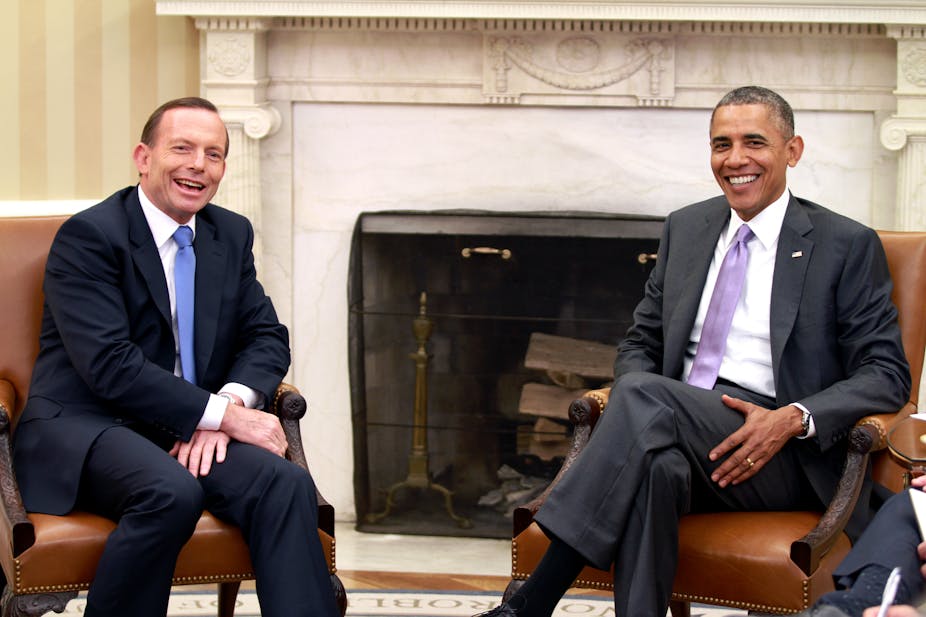As debate about the economic versus political role of the G20 takes hold, it’s worth looking back at how successfully member countries cooperated in promoting economic recovery after the global financial crisis.
In the early stages of the GFC, there was so much accord between the policies of the leading countries that it was common to talk not only of a new era of “G20” cooperation, but also of a “G2” – made up of the US and a rising China.
Indeed, the US and China combined for nearly US$1.5 billion in early fiscal stimulus. This crucially helped to place an important floor under a potential global economic collapse.
To be sure, the concept of a formal “G2” of economic leaders was always oversold. There are too many differences dividing the United States and China to expect the two to work closely in coordinating macroeconomic policies.
However, if one thinks of the world economy as having three centres of gravity – the US, China and Europe – the post-GFC era has seen the G2 of the US and China pursue more broadly responsible policies than the Europeans, whose concerns for austerity have held back economic growth. In turn, these contrasting policies have important implications for the Australian national interest and Australia’s leadership at the G20.
Picking a regional winner
First, with respect to China, one can see its regional economic responsibility and leadership in Asia stretching all the way back to the Asian crises of 1997-1999. In the face of a collapse of regional exchange rates, China held tight in the late 1990s and did not devalue its own currency to maintain export competitiveness.
Such a move would have made regional recovery much more difficult, as states facing economic “hard times” might have faced an even more difficult path to revived competitiveness. The Chinese response to the GFC only continued this trend of policy responsibility and an unwillingness to engage in “beggar-thy-neighbour” styled policies.
Similarly, the US followed up the GFC with not only a massive fiscal stimulus, but also sustained monetary policy activism. Indeed, the dysfunction in the American Congress contrasts nicely with the responsibility of the US Federal Reserve, which has proved willing to risk considerable criticism of its unconventional monetary policies and successive rounds of “quantitative easing.”
The fear that such policies would prove inflationary was never one to be taken seriously – as high unemployment rates in the US and elsewhere meant that the wage-price pressures necessary to inflation were never in the offing. The “tapering” of “QE3” remains a concern as states worry that it will result in a flight of capital back to the US – but the Federal Reserve’s gradualist approach seems to have eased such potential excesses.
In contrast to these success stories, it is not even clear if a European recovery has truly begun, with economic growth remaining stuck below 1%. The European debt crisis was the definition of a self-inflicted wound – as Greece could have easily been bailed out with a mere $50 billion or so, appropriately timed.
As it stands, the EU’s overall unemployment rate remains in double digits, at 10.6%. Broken down regionally, it gets worse. Spain’s unemployment rate is over 25%. Italy is at 14%. These are numbers that evoke notions of “lost generations” – and over time fuel political extremism.
Moreover, Europe’s weakness matters to the rest of the world. As the IMF noted in the context of its recent review of the Chinese economy, “the main external risks to China are renewed financial distress in the euro area” and “a protracted period of slower euro area growth”.
Nevertheless there are some signs of European movement, as the European Central Bank has pushed interest rates into negative territory and France and Italy have been pushing for a relaxation of budgetary rules.
Why Australia should care
This “scorecard” of economic performances across the “G3” has implications for Australian foreign policy, calling into question arguments that Australia must choose either its political partner in the US, or its economic partner in China. Indeed, Australia, China and the US all share an interest in European growth. Even Australian opponents of Keynesian stimulus at home have reasons to favour it abroad: for, if the Europeans run deficits, Australia will be more free to pursue surplus.
To return to the Australian agenda for the upcoming G20 summit, it is worth reviving Henry Kissinger’s notion of a “constructive ambiguity” as useful for enabling countries to “paper over” their differences. The top item on the Australian agenda for the summit is growth. This is an appealing objective that everyone can support in the abstract – but hopefully, behind closed doors, it will provide a means for the G20 – and “G2” – to confront the main source of lagging global growth, in the EU. As John Maynard Keynes famously wrote:
“If our poverty were due to famine or earthquake or war—if we lacked material things and the resources to produce them, we could not expect to find the Means to Prosperity except in hard work, abstinence, and invention. In fact, our predicament is notoriously of another kind.
It comes from some failure in the immaterial devices of the mind, in the working of the motives which should lead to the decisions and acts of will, necessary to put in movement the resources and technical means we already have.
It is as though two motor-drivers, meeting in the middle of a highway, were unable to pass one another because neither knows the rule of the road. Their own muscles are no use; a motor engineer cannot help them; a better road would not serve. Nothing is required and nothing will avail, except a little, a very little, clear thinking.”

